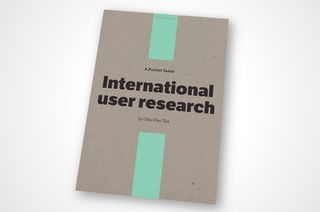Chui Chui Tan on the importance of international user research
User experience consultant Chui Chui Tan talks to Martin Cooper about international user research and how to do it.
Why don't you introduce yourself?
I'm Chui Chui Tan. I currently work for a UK customer experience consultancy, cxpartners. I help clients like Marriott, Clarks and Nokia create a better multichannel experience for their customers globally, across Europe, Asia, Middle East, North and South America. While running and managing projects, I oversee the development of our company's international research projects. I'm also the UX design editor for Smashing Magazine.
Is a good interaction a science or an art?
Both! That's what makes interaction design and user experience interesting. To me, a good interaction design should incorporate user research, psychology principles and creativity. You need the research to help you understand users' behaviours and expectations; then you take psychological theories and add some creativity to come out with an effective and desirable design.
How and why should a product maker start thinking about going international?
Well, to be honest, in the world we are living now, there's no other way than thinking globally.
Most people think they need to consider global audiences only when they're selling their products or services in more than one country. This isn't the right thinking. The products we make nowadays will no longer be used by one nation.
Many companies are already looking into getting into global markets as expanding into new markets is key to growth. One common mistake companies, especially the big ones, often make is that, when they first design their products and build their services, they focus solely on the needs of one main market. Only when they start thinking about going to other markets, do they want to learn more about those markets and incorporate what they've found into their existing design or strategy. This sometimes means huge amounts of tweaking are needed to the existing system or design to fit into the local markets. That costs additional money, time and effort.
A more appropriate approach is to design and build our products and services with global audiences in mind from the very beginning, even though we may focus on only one or two markets for now. Thinking globally from the very beginning is the way to go.
Surely this kind of research is expensive and only achievable by big corporations?
Not at all. Cultural research doesn't always have to be expensive. There are various ways to understand your global users. In my book (International User Research), I've listed a number of global research approaches. Some can be carried out with minimum budget. For example, you can use unmoderated remote testing tools such as UserTesting.com and WhatUsersDo.com to test some functional elements of your design. At cxpartners, we use the former for the US markets and the latter for the UK and EU markets. Alternatively, you can also do online surveys by using tools such as SurveyMonkey to collect quantitative and qualitative data from various markets.

If you want to talk to your local users directly, you can do moderated remote interviews with them via tools such as Skype, GoToMeeting or WebEx. Let's say you already have a customer list that you can use for the recruitment and you do the recruitment yourself, the only possible cost involved for the research may just be the incentives (vouchers or discount codes). That's not a lot of money when compared to the invaluable insight you get out of the research, is it?
It's always useful for the team to get out to the country with the research team to observe the interviews, gain first-hand insights and immerse into the local culture. Of course, this means you'll need a bigger budget, but the benefits could easily out-weigh the costs.
Words: Martin Cooper
This article originally appeared in net magazine issue 251.

Thank you for reading 5 articles this month* Join now for unlimited access
Enjoy your first month for just £1 / $1 / €1
*Read 5 free articles per month without a subscription

Join now for unlimited access
Try first month for just £1 / $1 / €1
Get the Creative Bloq Newsletter
Daily design news, reviews, how-tos and more, as picked by the editors.
The Creative Bloq team is made up of a group of design fans, and has changed and evolved since Creative Bloq began back in 2012. The current website team consists of eight full-time members of staff: Editor Georgia Coggan, Deputy Editor Rosie Hilder, Ecommerce Editor Beren Neale, Senior News Editor Daniel Piper, Editor, Digital Art and 3D Ian Dean, Tech Reviews Editor Erlingur Einarsson and Ecommerce Writer Beth Nicholls and Staff Writer Natalie Fear, as well as a roster of freelancers from around the world. The 3D World and ImagineFX magazine teams also pitch in, ensuring that content from 3D World and ImagineFX is represented on Creative Bloq.
